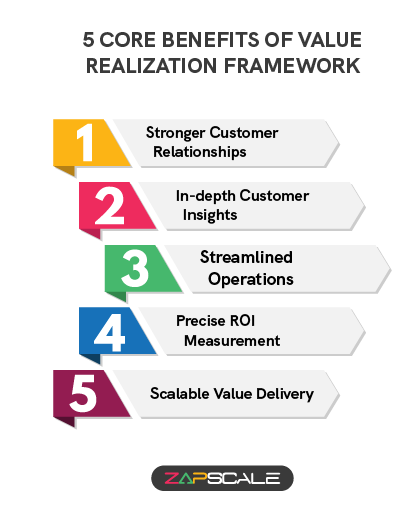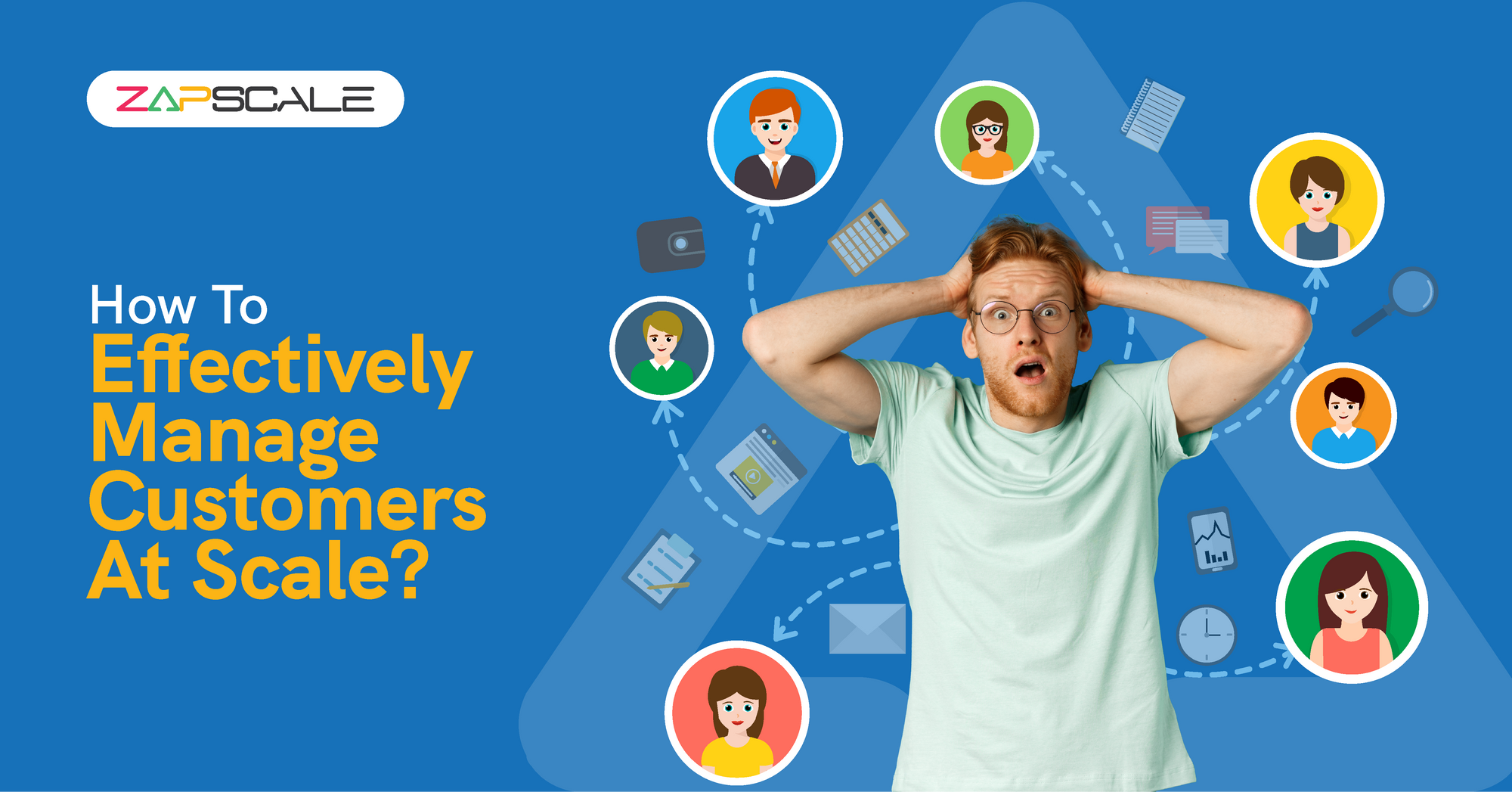CATEGORY > Customer Success Management
Value Realization Framework: Empowering SaaS Businesses for Strategic Expansion

Introduction
In a business model as dynamic as SaaS, profitability and business sustainability depend on factors like development, marketing, and customer success.
However, most SaaS organizations do not give customer success—the attention it deserves, leading to a high attrition rate and business instability.
Value realization framework is a strategy focused on customer-focused growth and a key contributor to SaaS success.
Businesses that prioritize customer value over sales can increase customer satisfaction, reduce churn, and drive growth.

Let’s continue reading further to learn about this phenomenal concept.
What Defines A Customer Journey?
A "Customer Journey" can be defined as the sum of all interactions a customer has with a brand before, during, and after a purchase.
It includes every interaction the said customer has with a company, from the first time they learn about it until their final purchase and beyond.
In a customer journey, we find many stages that combine the overall customer experience.
Let’s discuss those stages in brief.
1. Awareness
Here, the customer learns about the brand or product through marketing, recommendations, or other channels.
2. Consideration
Customers research and compare choices, including features, costs, and reviews.
3. Decision
At this point, the customer decides to buy, influenced by factors such as promotions or customer service.
4. Purchase
The transaction takes place, and the customer interacts with the purchasing platform.
5. Onboarding
The customer is introduced to the product or service, which often includes setup or training.
6. Usage
The customer actively utilizes the product or service, experiencing its benefits and support.
7. Support
At this stage, customers seek support or assistance to improve their satisfaction.
8. Loyalty
The final stage demonstrates the customer's continued engagement with the company, including repeat purchases and advocacy.
By mapping out these above stages, SaaS brands can discover pain points and opportunities to improve customers' satisfaction and loyalty.
Understanding The Concept Of Value Realization
Value realization is a strategy that demonstrates the ongoing value of a product or service to customers.
It assures that customers continuously receive and perceive the true value of a product or service, beyond their initial expectations.
Value realization begins after onboarding when customers first notice the benefits and continue as they regularly obtain greater value than anticipated.
It entails monitoring the true business impact of a solution on customers, operations, and shareholder value.
Finally, value realization promotes customer satisfaction, loyalty, and business development. This technique aids in the measurement and enhancement of the tangible advantages provided by the product or service over time.
What Is Value Realization Framework?
A value realization framework is a strategic approach that helps firms constantly surpass customer expectations.
To put it simply, a business value realization framework guarantees that customers consistently receive and recognize the complete value of a product or service.
It starts during or immediately after onboarding, with behaviors geared toward delivering and showing the value of a product or service.
The framework contains procedures for tracking and optimizing this value over time, intending to convert initial gratification into long-term value.
Customers are more likely to become committed customers and ardent brand advocates when they witness consistent benefits that exceed their expectations.
This framework enables firms to maintain a clear, systematic approach to value delivery, ultimately increasing customer satisfaction and driving long-term success.
Core Benefits Of Value Realization Framework
Value realization framework allows both customers and SaaS brands to make the most of their investments, whether it’s in terms of time or money.
Let’s figure out what other benefits we can expect after deploying this strategic approach.

1. Stronger Customer Relationships
A value realization framework aids in the development of stronger and more meaningful customer connections by emphasizing constant value delivery.
Customers who feel engaged and valued are more likely to provide useful feedback, collaborate on product enhancements, and become long-term partners in the company's success.
2. In-Depth Customer Insights
One of the biggest advantages of having a robust value realization framework is that it provides deeper insights into customer behavior and preferences.
These regular insights can reveal the hidden potential for innovation and improvement, allowing firms better to tailor their services to their customers' evolving demands.
3. Streamlined Operation
Improved operational efficiency contributes to greater overall performance and cost control.
This framework pushes SaaS enterprises to improve their operations and focus on delivering value effectively. This results in more efficient operations as businesses optimize their workflows and eliminate inefficiencies.
4. Precise ROI Measurement
A value realization framework delivers a structured approach that makes it easy to measure accurate return on investment for both the company and its customers.
By tracking and assessing the value delivered, businesses can clearly illustrate the benefits of their products or services and justify their pricing.
5. Scalable Value Delivery
With a full-fledged value realization framework, SaaS businesses can enjoy scalable value delivery by implementing reliable procedures and best practices.
This scalability means that as the company's customer base increases, it can continue to provide high levels of value without sacrificing quality or efficiency.
How Customer Success Drives Tangible Value Realization?
Customer success teams ensure that customers receive optimal value out of a particular product or service.
To understand how customer success accelerates value realization, continue reading.
1. Proactive Support
Customer success teams identify and resolve potential issues before they become problems.
By offering proactive assistance, they avoid disruptions and ensure that customers get the most out of the product, resulting in smoother operations and greater value realization.
2. Boosting Product Adoption And Usage
With the aid of your customer success team, you can ensure better product acceptance and usage.
CS professionals assist customers in realizing the product's full potential and value by offering guidance, training, and support.
3. Feedback Collection
Customer success teams collect feedback regularly to understand how well the product is operating and where improvements are needed.
This feedback loop enables ongoing modification of the product and services, ensuring that customer needs are addressed and value is generated.
4. Strategic Guidance
Personalized guidance and support can surely enhance the value proposition.
Customer success executives offer strategic guidance on how to best use the product to meet corporate goals.
This guide enables customers to incorporate best practices and make educated decisions, resulting in improved outcomes and more value realization.
Value Realization Metrics
Yes, it’s possible to quantify Value Realization via some proven metrics as mentioned below.

1. Customer Satisfaction Scores
Measuring customer satisfaction with surveys and net promoter scores (NPS) provides instant insights into how well the product meets customer demands.
High satisfaction levels are often linked with successful value realization, as delighted buyers are more likely to believe they are obtaining significant benefits from the product.
2. Feature Adoption Rate
Tracking the adoption of various features provides information about which functionalities are most valued by customers.
High adoption rates for key features indicate that the product is successfully delivering the promised advantages, whereas low adoption may indicate areas for development.
3. Customer Retention Rates
High retention rates are a clear sign of value realization.
Customers who continue to use the product over time indicate that they are finding continued value and are pleased with their investment, which is a significant indicator of the product's success.
4. Attrition Rates
After measuring customer retention, it’s crucial to learn about the percentage of people who are departing.
Monitoring churn rates reveal how many customers abandon the product.
A high churn rate may imply that the product does not satisfy expectations or provide adequate value.
Reduced churn is crucial for increasing value realization and sustaining customer happiness.
5. Customer Success Metrics
Metrics such as customer health scores, adoption rates, and success milestones measure the overall efficacy of customer success programs.
These indicators determine whether customers are meeting their objectives and receiving the value they expect from the product.
FAQs
1. Can a value realization framework improve customer retention?
Yes, by ensuring that customers perceive ongoing value, you can lower churn and boost customer retention.
2. How to map the customer journey that supports value realization?
Mapping the customer journey helps to discover pain points and opportunities, allowing for targeted improvements that increase total value delivery.
3. How is customer success associated with value realization?
Customer success is critical for value realization because it influences customer happiness, product adoption, and overall value perception.
ABOUT THE AUTHOR
Sonali is a social media enthusiast and creative content writer with 3+ years of experience. With a passion for storytelling, Sonali delivers content that inspires, informs, and captivate readers.
Popular from Customer Success Management
Quality Content,
Straight To Your Inbox!
Subscribe for the latest blogs, podcasts, webinars, and events!

Write a Blog
If you have experience in CS and
a flair for writing, we’d love to
feature you.
Write to us on
hello@zapscale.com




